102EMM: Fibre Reinforced Composites in Automotive Structures
VerifiedAdded on 2022/12/01
|11
|2924
|144
Report
AI Summary
This report delves into the application of fibre-reinforced composite materials in the automotive industry, highlighting their advantages over traditional materials like steel. The introduction emphasizes the automotive industry's shift towards composite materials to improve efficiency, reduce weight, and minimize environmental impact. The report discusses the benefits of fibre-reinforced materials, including enhanced impact strength, ease of moulding, and improved aesthetics, leading to significant weight reduction and reduced emissions. It explores the joining processes used to connect composite and frame steels, emphasizing the importance of selecting the right parameters. The research also covers material selection, automotive design, and manufacturing processes, considering factors like lightweight properties, cost-effectiveness, safety, and recyclability. The report underscores how fibre-reinforced composites offer weight savings, strength, and versatility to meet new requirements. The conclusion summarizes the key findings and the future role of composite materials in the automotive sector.
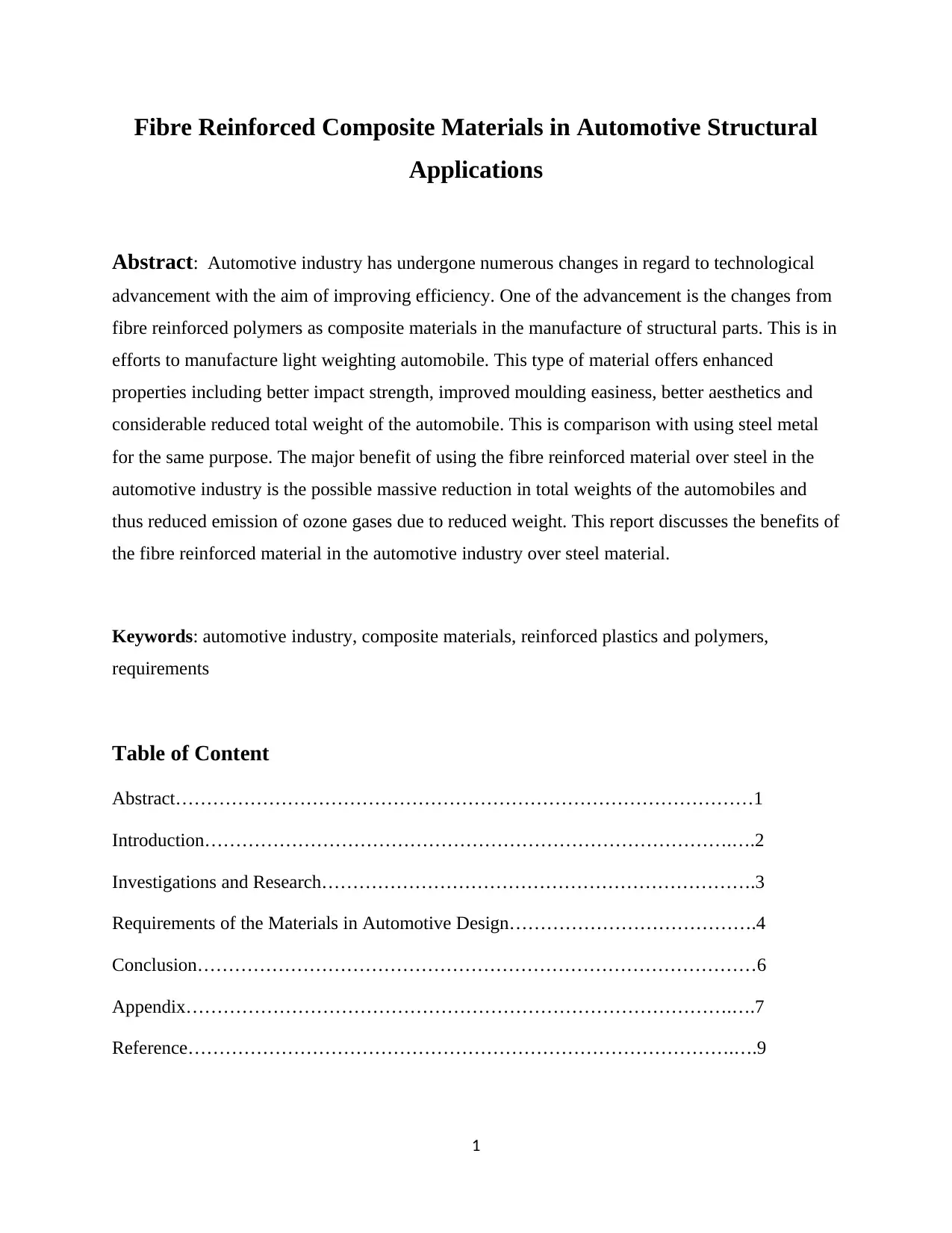
Fibre Reinforced Composite Materials in Automotive Structural
Applications
Abstract: Automotive industry has undergone numerous changes in regard to technological
advancement with the aim of improving efficiency. One of the advancement is the changes from
fibre reinforced polymers as composite materials in the manufacture of structural parts. This is in
efforts to manufacture light weighting automobile. This type of material offers enhanced
properties including better impact strength, improved moulding easiness, better aesthetics and
considerable reduced total weight of the automobile. This is comparison with using steel metal
for the same purpose. The major benefit of using the fibre reinforced material over steel in the
automotive industry is the possible massive reduction in total weights of the automobiles and
thus reduced emission of ozone gases due to reduced weight. This report discusses the benefits of
the fibre reinforced material in the automotive industry over steel material.
Keywords: automotive industry, composite materials, reinforced plastics and polymers,
requirements
Table of Content
Abstract…………………………………………………………………………………1
Introduction………………………………………………………………………….….2
Investigations and Research…………………………………………………………….3
Requirements of the Materials in Automotive Design………………………………….4
Conclusion………………………………………………………………………………6
Appendix…………………………………………………………………………….….7
Reference…………………………………………………………………………….….9
1
Applications
Abstract: Automotive industry has undergone numerous changes in regard to technological
advancement with the aim of improving efficiency. One of the advancement is the changes from
fibre reinforced polymers as composite materials in the manufacture of structural parts. This is in
efforts to manufacture light weighting automobile. This type of material offers enhanced
properties including better impact strength, improved moulding easiness, better aesthetics and
considerable reduced total weight of the automobile. This is comparison with using steel metal
for the same purpose. The major benefit of using the fibre reinforced material over steel in the
automotive industry is the possible massive reduction in total weights of the automobiles and
thus reduced emission of ozone gases due to reduced weight. This report discusses the benefits of
the fibre reinforced material in the automotive industry over steel material.
Keywords: automotive industry, composite materials, reinforced plastics and polymers,
requirements
Table of Content
Abstract…………………………………………………………………………………1
Introduction………………………………………………………………………….….2
Investigations and Research…………………………………………………………….3
Requirements of the Materials in Automotive Design………………………………….4
Conclusion………………………………………………………………………………6
Appendix…………………………………………………………………………….….7
Reference…………………………………………………………………………….….9
1
Paraphrase This Document
Need a fresh take? Get an instant paraphrase of this document with our AI Paraphraser
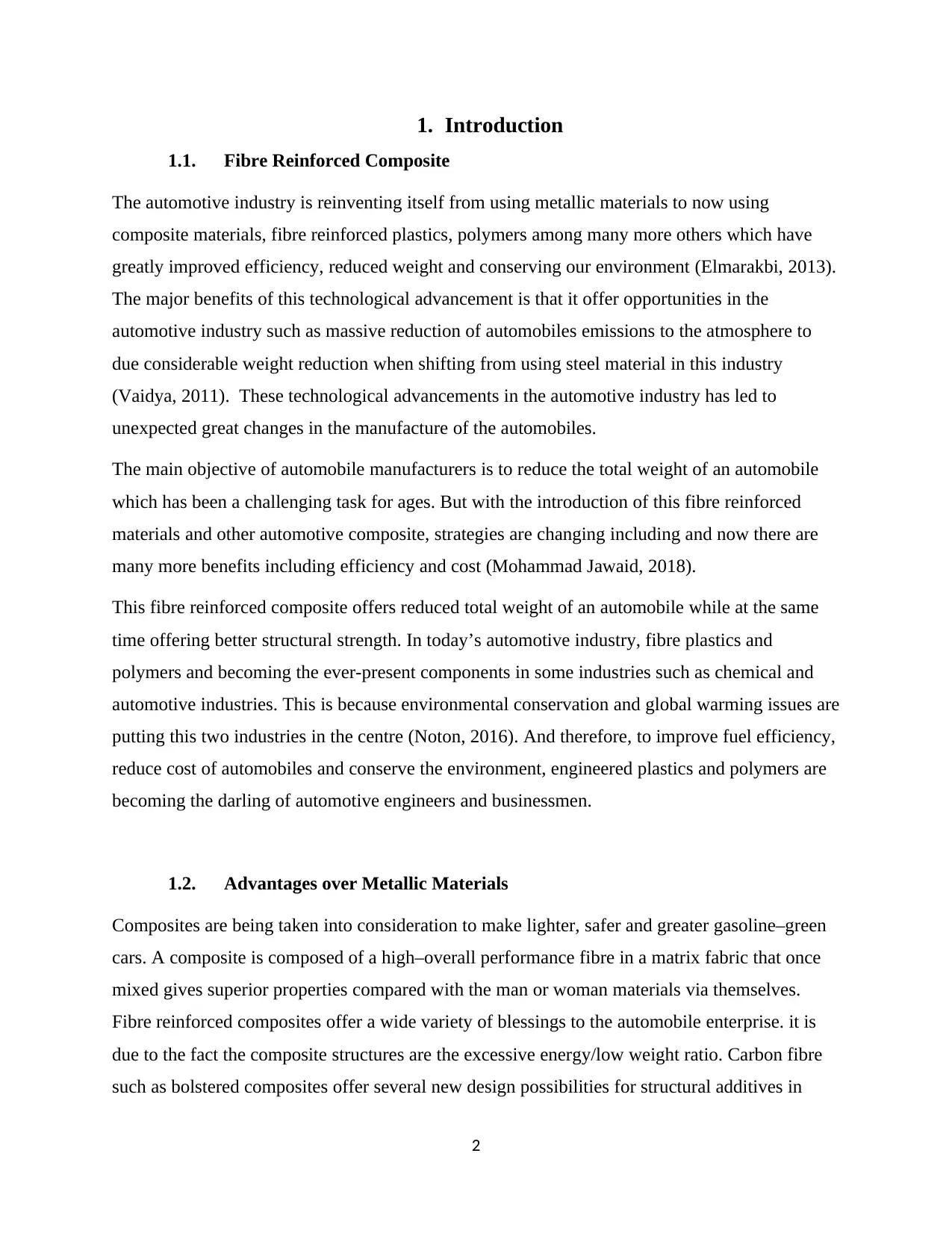
1. Introduction
1.1. Fibre Reinforced Composite
The automotive industry is reinventing itself from using metallic materials to now using
composite materials, fibre reinforced plastics, polymers among many more others which have
greatly improved efficiency, reduced weight and conserving our environment (Elmarakbi, 2013).
The major benefits of this technological advancement is that it offer opportunities in the
automotive industry such as massive reduction of automobiles emissions to the atmosphere to
due considerable weight reduction when shifting from using steel material in this industry
(Vaidya, 2011). These technological advancements in the automotive industry has led to
unexpected great changes in the manufacture of the automobiles.
The main objective of automobile manufacturers is to reduce the total weight of an automobile
which has been a challenging task for ages. But with the introduction of this fibre reinforced
materials and other automotive composite, strategies are changing including and now there are
many more benefits including efficiency and cost (Mohammad Jawaid, 2018).
This fibre reinforced composite offers reduced total weight of an automobile while at the same
time offering better structural strength. In today’s automotive industry, fibre plastics and
polymers and becoming the ever-present components in some industries such as chemical and
automotive industries. This is because environmental conservation and global warming issues are
putting this two industries in the centre (Noton, 2016). And therefore, to improve fuel efficiency,
reduce cost of automobiles and conserve the environment, engineered plastics and polymers are
becoming the darling of automotive engineers and businessmen.
1.2. Advantages over Metallic Materials
Composites are being taken into consideration to make lighter, safer and greater gasoline–green
cars. A composite is composed of a high–overall performance fibre in a matrix fabric that once
mixed gives superior properties compared with the man or woman materials via themselves.
Fibre reinforced composites offer a wide variety of blessings to the automobile enterprise. it is
due to the fact the composite structures are the excessive energy/low weight ratio. Carbon fibre
such as bolstered composites offer several new design possibilities for structural additives in
2
1.1. Fibre Reinforced Composite
The automotive industry is reinventing itself from using metallic materials to now using
composite materials, fibre reinforced plastics, polymers among many more others which have
greatly improved efficiency, reduced weight and conserving our environment (Elmarakbi, 2013).
The major benefits of this technological advancement is that it offer opportunities in the
automotive industry such as massive reduction of automobiles emissions to the atmosphere to
due considerable weight reduction when shifting from using steel material in this industry
(Vaidya, 2011). These technological advancements in the automotive industry has led to
unexpected great changes in the manufacture of the automobiles.
The main objective of automobile manufacturers is to reduce the total weight of an automobile
which has been a challenging task for ages. But with the introduction of this fibre reinforced
materials and other automotive composite, strategies are changing including and now there are
many more benefits including efficiency and cost (Mohammad Jawaid, 2018).
This fibre reinforced composite offers reduced total weight of an automobile while at the same
time offering better structural strength. In today’s automotive industry, fibre plastics and
polymers and becoming the ever-present components in some industries such as chemical and
automotive industries. This is because environmental conservation and global warming issues are
putting this two industries in the centre (Noton, 2016). And therefore, to improve fuel efficiency,
reduce cost of automobiles and conserve the environment, engineered plastics and polymers are
becoming the darling of automotive engineers and businessmen.
1.2. Advantages over Metallic Materials
Composites are being taken into consideration to make lighter, safer and greater gasoline–green
cars. A composite is composed of a high–overall performance fibre in a matrix fabric that once
mixed gives superior properties compared with the man or woman materials via themselves.
Fibre reinforced composites offer a wide variety of blessings to the automobile enterprise. it is
due to the fact the composite structures are the excessive energy/low weight ratio. Carbon fibre
such as bolstered composites offer several new design possibilities for structural additives in
2
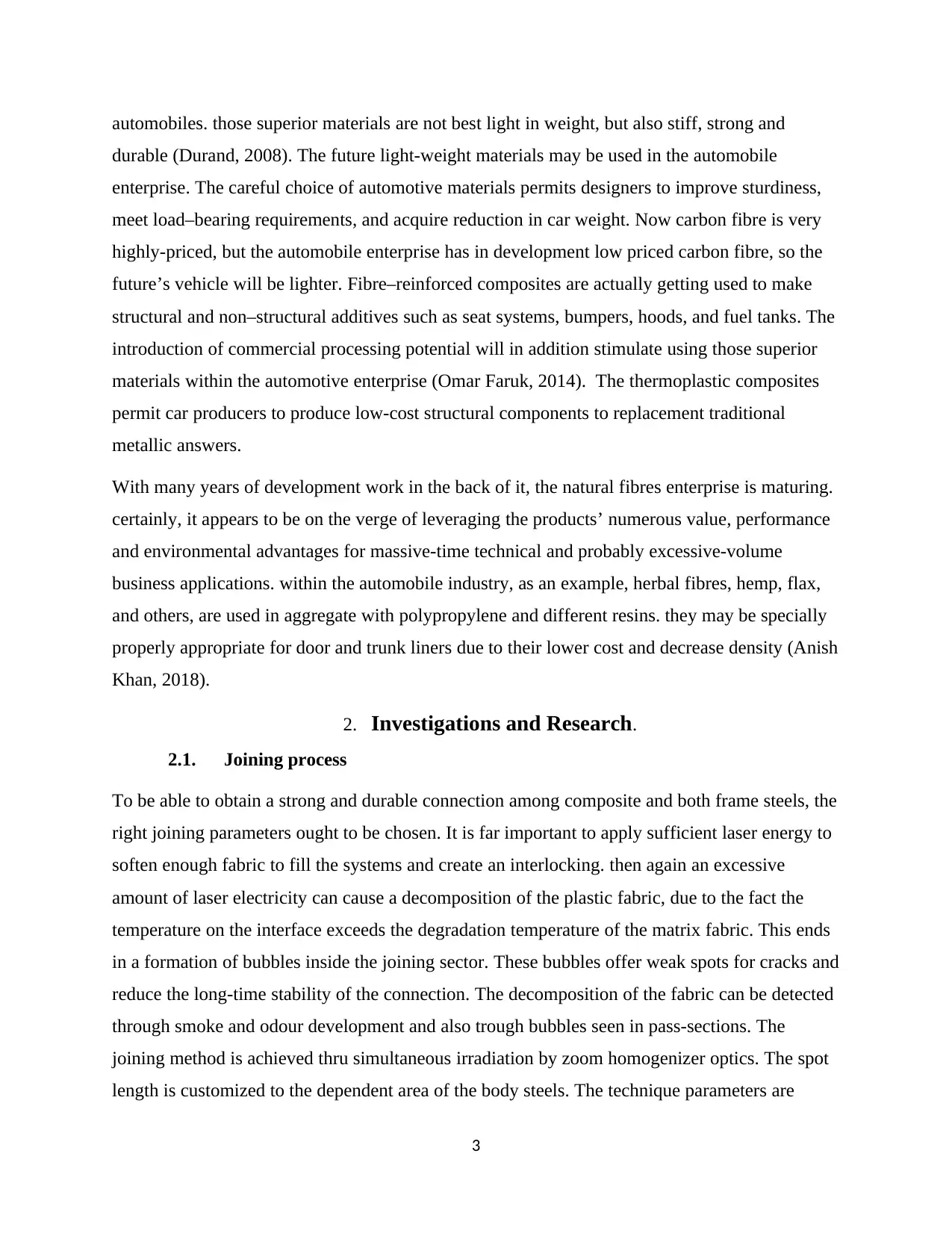
automobiles. those superior materials are not best light in weight, but also stiff, strong and
durable (Durand, 2008). The future light-weight materials may be used in the automobile
enterprise. The careful choice of automotive materials permits designers to improve sturdiness,
meet load–bearing requirements, and acquire reduction in car weight. Now carbon fibre is very
highly-priced, but the automobile enterprise has in development low priced carbon fibre, so the
future’s vehicle will be lighter. Fibre–reinforced composites are actually getting used to make
structural and non–structural additives such as seat systems, bumpers, hoods, and fuel tanks. The
introduction of commercial processing potential will in addition stimulate using those superior
materials within the automotive enterprise (Omar Faruk, 2014). The thermoplastic composites
permit car producers to produce low-cost structural components to replacement traditional
metallic answers.
With many years of development work in the back of it, the natural fibres enterprise is maturing.
certainly, it appears to be on the verge of leveraging the products’ numerous value, performance
and environmental advantages for massive-time technical and probably excessive-volume
business applications. within the automobile industry, as an example, herbal fibres, hemp, flax,
and others, are used in aggregate with polypropylene and different resins. they may be specially
properly appropriate for door and trunk liners due to their lower cost and decrease density (Anish
Khan, 2018).
2. Investigations and Research.
2.1. Joining process
To be able to obtain a strong and durable connection among composite and both frame steels, the
right joining parameters ought to be chosen. It is far important to apply sufficient laser energy to
soften enough fabric to fill the systems and create an interlocking. then again an excessive
amount of laser electricity can cause a decomposition of the plastic fabric, due to the fact the
temperature on the interface exceeds the degradation temperature of the matrix fabric. This ends
in a formation of bubbles inside the joining sector. These bubbles offer weak spots for cracks and
reduce the long-time stability of the connection. The decomposition of the fabric can be detected
through smoke and odour development and also trough bubbles seen in pass-sections. The
joining method is achieved thru simultaneous irradiation by zoom homogenizer optics. The spot
length is customized to the dependent area of the body steels. The technique parameters are
3
durable (Durand, 2008). The future light-weight materials may be used in the automobile
enterprise. The careful choice of automotive materials permits designers to improve sturdiness,
meet load–bearing requirements, and acquire reduction in car weight. Now carbon fibre is very
highly-priced, but the automobile enterprise has in development low priced carbon fibre, so the
future’s vehicle will be lighter. Fibre–reinforced composites are actually getting used to make
structural and non–structural additives such as seat systems, bumpers, hoods, and fuel tanks. The
introduction of commercial processing potential will in addition stimulate using those superior
materials within the automotive enterprise (Omar Faruk, 2014). The thermoplastic composites
permit car producers to produce low-cost structural components to replacement traditional
metallic answers.
With many years of development work in the back of it, the natural fibres enterprise is maturing.
certainly, it appears to be on the verge of leveraging the products’ numerous value, performance
and environmental advantages for massive-time technical and probably excessive-volume
business applications. within the automobile industry, as an example, herbal fibres, hemp, flax,
and others, are used in aggregate with polypropylene and different resins. they may be specially
properly appropriate for door and trunk liners due to their lower cost and decrease density (Anish
Khan, 2018).
2. Investigations and Research.
2.1. Joining process
To be able to obtain a strong and durable connection among composite and both frame steels, the
right joining parameters ought to be chosen. It is far important to apply sufficient laser energy to
soften enough fabric to fill the systems and create an interlocking. then again an excessive
amount of laser electricity can cause a decomposition of the plastic fabric, due to the fact the
temperature on the interface exceeds the degradation temperature of the matrix fabric. This ends
in a formation of bubbles inside the joining sector. These bubbles offer weak spots for cracks and
reduce the long-time stability of the connection. The decomposition of the fabric can be detected
through smoke and odour development and also trough bubbles seen in pass-sections. The
joining method is achieved thru simultaneous irradiation by zoom homogenizer optics. The spot
length is customized to the dependent area of the body steels. The technique parameters are
3
⊘ This is a preview!⊘
Do you want full access?
Subscribe today to unlock all pages.

Trusted by 1+ million students worldwide
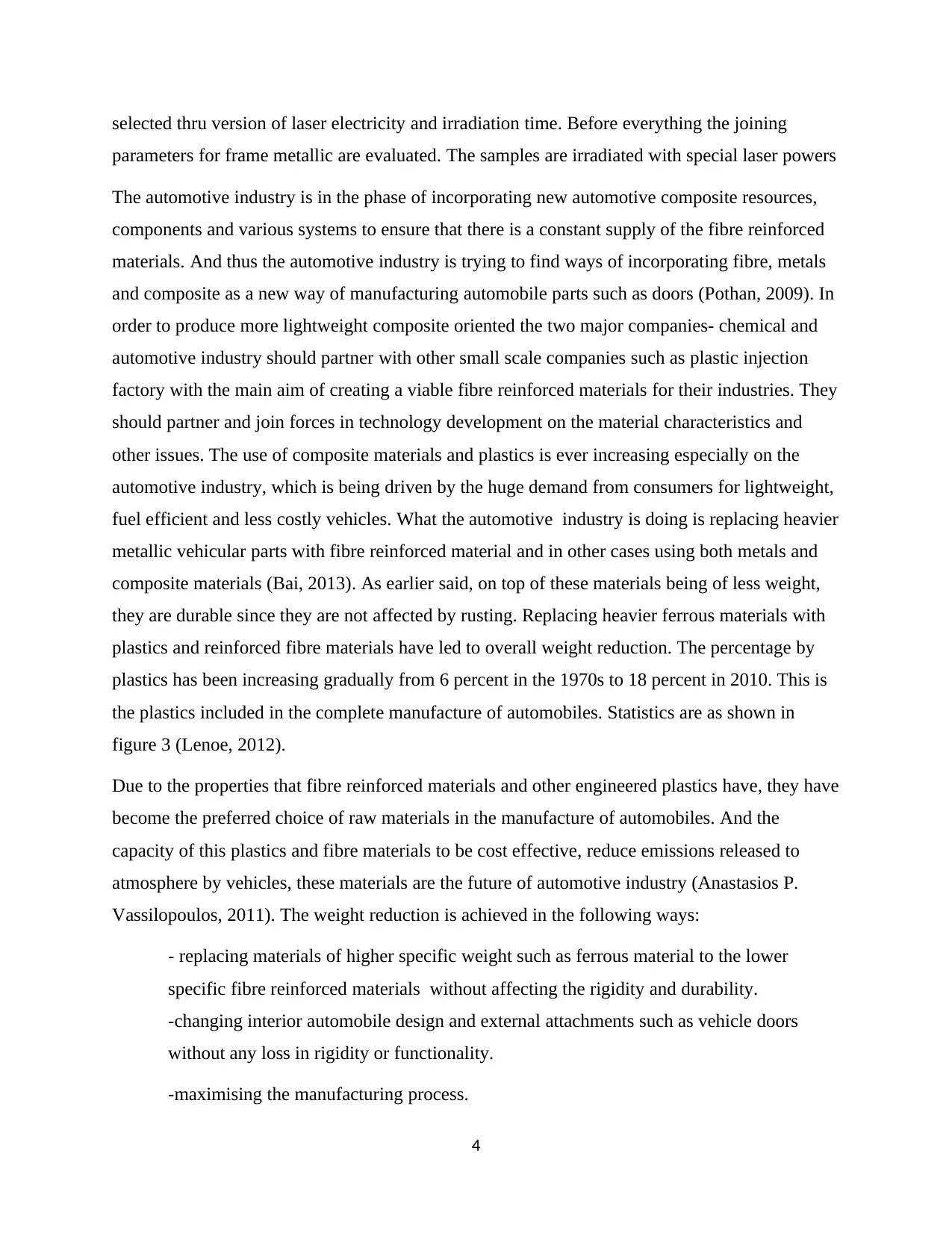
selected thru version of laser electricity and irradiation time. Before everything the joining
parameters for frame metallic are evaluated. The samples are irradiated with special laser powers
The automotive industry is in the phase of incorporating new automotive composite resources,
components and various systems to ensure that there is a constant supply of the fibre reinforced
materials. And thus the automotive industry is trying to find ways of incorporating fibre, metals
and composite as a new way of manufacturing automobile parts such as doors (Pothan, 2009). In
order to produce more lightweight composite oriented the two major companies- chemical and
automotive industry should partner with other small scale companies such as plastic injection
factory with the main aim of creating a viable fibre reinforced materials for their industries. They
should partner and join forces in technology development on the material characteristics and
other issues. The use of composite materials and plastics is ever increasing especially on the
automotive industry, which is being driven by the huge demand from consumers for lightweight,
fuel efficient and less costly vehicles. What the automotive industry is doing is replacing heavier
metallic vehicular parts with fibre reinforced material and in other cases using both metals and
composite materials (Bai, 2013). As earlier said, on top of these materials being of less weight,
they are durable since they are not affected by rusting. Replacing heavier ferrous materials with
plastics and reinforced fibre materials have led to overall weight reduction. The percentage by
plastics has been increasing gradually from 6 percent in the 1970s to 18 percent in 2010. This is
the plastics included in the complete manufacture of automobiles. Statistics are as shown in
figure 3 (Lenoe, 2012).
Due to the properties that fibre reinforced materials and other engineered plastics have, they have
become the preferred choice of raw materials in the manufacture of automobiles. And the
capacity of this plastics and fibre materials to be cost effective, reduce emissions released to
atmosphere by vehicles, these materials are the future of automotive industry (Anastasios P.
Vassilopoulos, 2011). The weight reduction is achieved in the following ways:
- replacing materials of higher specific weight such as ferrous material to the lower
specific fibre reinforced materials without affecting the rigidity and durability.
-changing interior automobile design and external attachments such as vehicle doors
without any loss in rigidity or functionality.
-maximising the manufacturing process.
4
parameters for frame metallic are evaluated. The samples are irradiated with special laser powers
The automotive industry is in the phase of incorporating new automotive composite resources,
components and various systems to ensure that there is a constant supply of the fibre reinforced
materials. And thus the automotive industry is trying to find ways of incorporating fibre, metals
and composite as a new way of manufacturing automobile parts such as doors (Pothan, 2009). In
order to produce more lightweight composite oriented the two major companies- chemical and
automotive industry should partner with other small scale companies such as plastic injection
factory with the main aim of creating a viable fibre reinforced materials for their industries. They
should partner and join forces in technology development on the material characteristics and
other issues. The use of composite materials and plastics is ever increasing especially on the
automotive industry, which is being driven by the huge demand from consumers for lightweight,
fuel efficient and less costly vehicles. What the automotive industry is doing is replacing heavier
metallic vehicular parts with fibre reinforced material and in other cases using both metals and
composite materials (Bai, 2013). As earlier said, on top of these materials being of less weight,
they are durable since they are not affected by rusting. Replacing heavier ferrous materials with
plastics and reinforced fibre materials have led to overall weight reduction. The percentage by
plastics has been increasing gradually from 6 percent in the 1970s to 18 percent in 2010. This is
the plastics included in the complete manufacture of automobiles. Statistics are as shown in
figure 3 (Lenoe, 2012).
Due to the properties that fibre reinforced materials and other engineered plastics have, they have
become the preferred choice of raw materials in the manufacture of automobiles. And the
capacity of this plastics and fibre materials to be cost effective, reduce emissions released to
atmosphere by vehicles, these materials are the future of automotive industry (Anastasios P.
Vassilopoulos, 2011). The weight reduction is achieved in the following ways:
- replacing materials of higher specific weight such as ferrous material to the lower
specific fibre reinforced materials without affecting the rigidity and durability.
-changing interior automobile design and external attachments such as vehicle doors
without any loss in rigidity or functionality.
-maximising the manufacturing process.
4
Paraphrase This Document
Need a fresh take? Get an instant paraphrase of this document with our AI Paraphraser
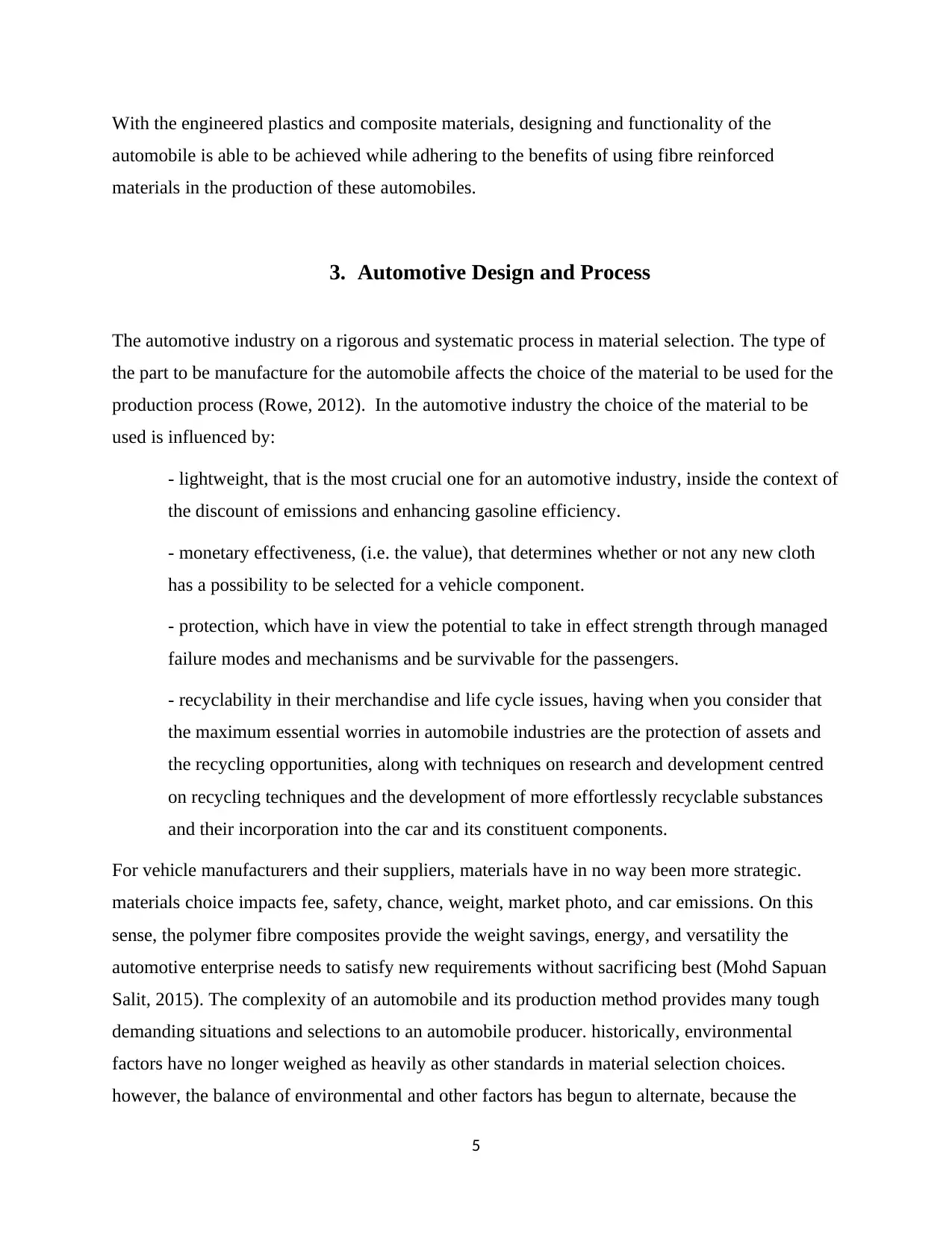
With the engineered plastics and composite materials, designing and functionality of the
automobile is able to be achieved while adhering to the benefits of using fibre reinforced
materials in the production of these automobiles.
3. Automotive Design and Process
The automotive industry on a rigorous and systematic process in material selection. The type of
the part to be manufacture for the automobile affects the choice of the material to be used for the
production process (Rowe, 2012). In the automotive industry the choice of the material to be
used is influenced by:
- lightweight, that is the most crucial one for an automotive industry, inside the context of
the discount of emissions and enhancing gasoline efficiency.
- monetary effectiveness, (i.e. the value), that determines whether or not any new cloth
has a possibility to be selected for a vehicle component.
- protection, which have in view the potential to take in effect strength through managed
failure modes and mechanisms and be survivable for the passengers.
- recyclability in their merchandise and life cycle issues, having when you consider that
the maximum essential worries in automobile industries are the protection of assets and
the recycling opportunities, along with techniques on research and development centred
on recycling techniques and the development of more effortlessly recyclable substances
and their incorporation into the car and its constituent components.
For vehicle manufacturers and their suppliers, materials have in no way been more strategic.
materials choice impacts fee, safety, chance, weight, market photo, and car emissions. On this
sense, the polymer fibre composites provide the weight savings, energy, and versatility the
automotive enterprise needs to satisfy new requirements without sacrificing best (Mohd Sapuan
Salit, 2015). The complexity of an automobile and its production method provides many tough
demanding situations and selections to an automobile producer. historically, environmental
factors have no longer weighed as heavily as other standards in material selection choices.
however, the balance of environmental and other factors has begun to alternate, because the
5
automobile is able to be achieved while adhering to the benefits of using fibre reinforced
materials in the production of these automobiles.
3. Automotive Design and Process
The automotive industry on a rigorous and systematic process in material selection. The type of
the part to be manufacture for the automobile affects the choice of the material to be used for the
production process (Rowe, 2012). In the automotive industry the choice of the material to be
used is influenced by:
- lightweight, that is the most crucial one for an automotive industry, inside the context of
the discount of emissions and enhancing gasoline efficiency.
- monetary effectiveness, (i.e. the value), that determines whether or not any new cloth
has a possibility to be selected for a vehicle component.
- protection, which have in view the potential to take in effect strength through managed
failure modes and mechanisms and be survivable for the passengers.
- recyclability in their merchandise and life cycle issues, having when you consider that
the maximum essential worries in automobile industries are the protection of assets and
the recycling opportunities, along with techniques on research and development centred
on recycling techniques and the development of more effortlessly recyclable substances
and their incorporation into the car and its constituent components.
For vehicle manufacturers and their suppliers, materials have in no way been more strategic.
materials choice impacts fee, safety, chance, weight, market photo, and car emissions. On this
sense, the polymer fibre composites provide the weight savings, energy, and versatility the
automotive enterprise needs to satisfy new requirements without sacrificing best (Mohd Sapuan
Salit, 2015). The complexity of an automobile and its production method provides many tough
demanding situations and selections to an automobile producer. historically, environmental
factors have no longer weighed as heavily as other standards in material selection choices.
however, the balance of environmental and other factors has begun to alternate, because the
5
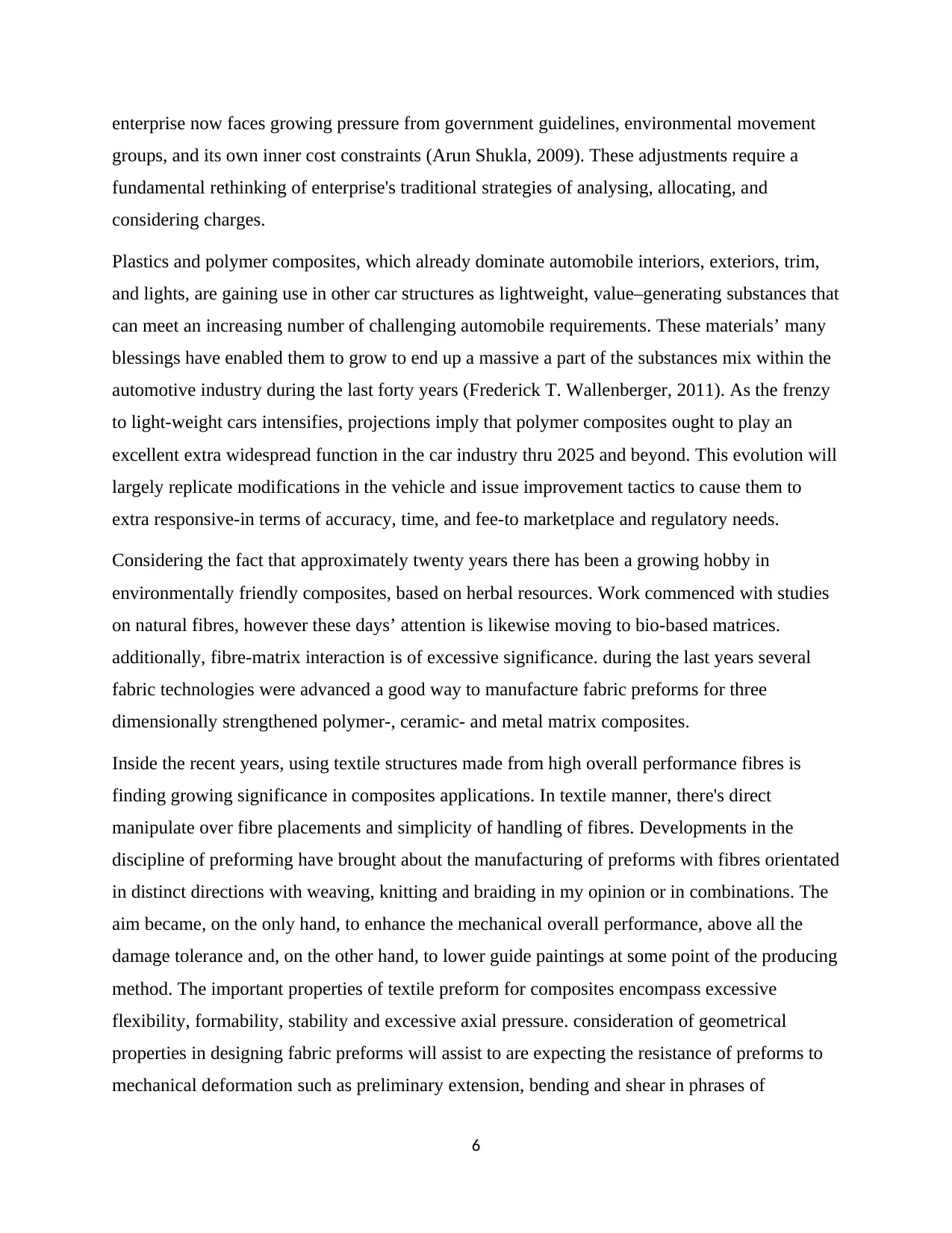
enterprise now faces growing pressure from government guidelines, environmental movement
groups, and its own inner cost constraints (Arun Shukla, 2009). These adjustments require a
fundamental rethinking of enterprise's traditional strategies of analysing, allocating, and
considering charges.
Plastics and polymer composites, which already dominate automobile interiors, exteriors, trim,
and lights, are gaining use in other car structures as lightweight, value–generating substances that
can meet an increasing number of challenging automobile requirements. These materials’ many
blessings have enabled them to grow to end up a massive a part of the substances mix within the
automotive industry during the last forty years (Frederick T. Wallenberger, 2011). As the frenzy
to light-weight cars intensifies, projections imply that polymer composites ought to play an
excellent extra widespread function in the car industry thru 2025 and beyond. This evolution will
largely replicate modifications in the vehicle and issue improvement tactics to cause them to
extra responsive-in terms of accuracy, time, and fee-to marketplace and regulatory needs.
Considering the fact that approximately twenty years there has been a growing hobby in
environmentally friendly composites, based on herbal resources. Work commenced with studies
on natural fibres, however these days’ attention is likewise moving to bio-based matrices.
additionally, fibre-matrix interaction is of excessive significance. during the last years several
fabric technologies were advanced a good way to manufacture fabric preforms for three
dimensionally strengthened polymer-, ceramic- and metal matrix composites.
Inside the recent years, using textile structures made from high overall performance fibres is
finding growing significance in composites applications. In textile manner, there's direct
manipulate over fibre placements and simplicity of handling of fibres. Developments in the
discipline of preforming have brought about the manufacturing of preforms with fibres orientated
in distinct directions with weaving, knitting and braiding in my opinion or in combinations. The
aim became, on the only hand, to enhance the mechanical overall performance, above all the
damage tolerance and, on the other hand, to lower guide paintings at some point of the producing
method. The important properties of textile preform for composites encompass excessive
flexibility, formability, stability and excessive axial pressure. consideration of geometrical
properties in designing fabric preforms will assist to are expecting the resistance of preforms to
mechanical deformation such as preliminary extension, bending and shear in phrases of
6
groups, and its own inner cost constraints (Arun Shukla, 2009). These adjustments require a
fundamental rethinking of enterprise's traditional strategies of analysing, allocating, and
considering charges.
Plastics and polymer composites, which already dominate automobile interiors, exteriors, trim,
and lights, are gaining use in other car structures as lightweight, value–generating substances that
can meet an increasing number of challenging automobile requirements. These materials’ many
blessings have enabled them to grow to end up a massive a part of the substances mix within the
automotive industry during the last forty years (Frederick T. Wallenberger, 2011). As the frenzy
to light-weight cars intensifies, projections imply that polymer composites ought to play an
excellent extra widespread function in the car industry thru 2025 and beyond. This evolution will
largely replicate modifications in the vehicle and issue improvement tactics to cause them to
extra responsive-in terms of accuracy, time, and fee-to marketplace and regulatory needs.
Considering the fact that approximately twenty years there has been a growing hobby in
environmentally friendly composites, based on herbal resources. Work commenced with studies
on natural fibres, however these days’ attention is likewise moving to bio-based matrices.
additionally, fibre-matrix interaction is of excessive significance. during the last years several
fabric technologies were advanced a good way to manufacture fabric preforms for three
dimensionally strengthened polymer-, ceramic- and metal matrix composites.
Inside the recent years, using textile structures made from high overall performance fibres is
finding growing significance in composites applications. In textile manner, there's direct
manipulate over fibre placements and simplicity of handling of fibres. Developments in the
discipline of preforming have brought about the manufacturing of preforms with fibres orientated
in distinct directions with weaving, knitting and braiding in my opinion or in combinations. The
aim became, on the only hand, to enhance the mechanical overall performance, above all the
damage tolerance and, on the other hand, to lower guide paintings at some point of the producing
method. The important properties of textile preform for composites encompass excessive
flexibility, formability, stability and excessive axial pressure. consideration of geometrical
properties in designing fabric preforms will assist to are expecting the resistance of preforms to
mechanical deformation such as preliminary extension, bending and shear in phrases of
6
⊘ This is a preview!⊘
Do you want full access?
Subscribe today to unlock all pages.

Trusted by 1+ million students worldwide
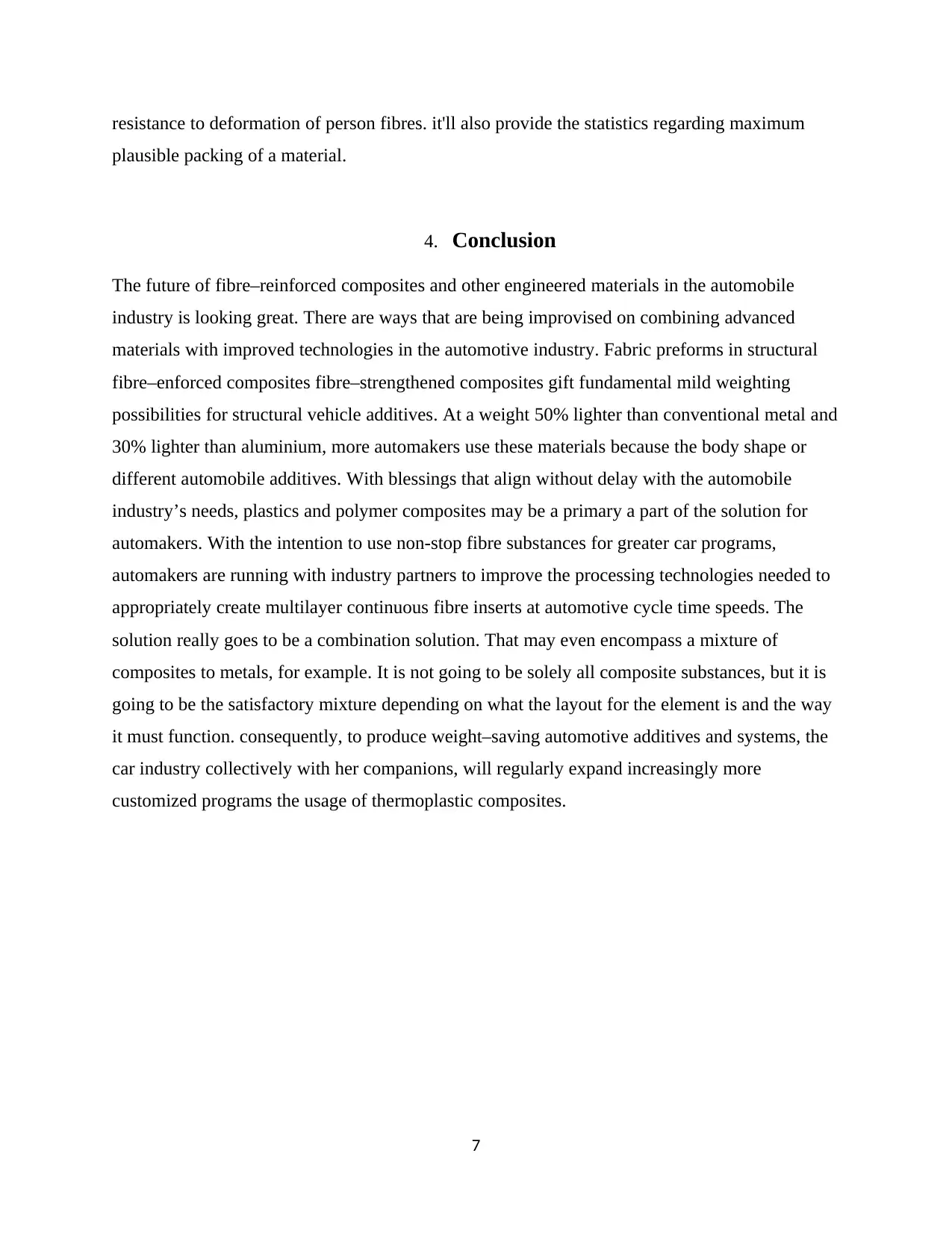
resistance to deformation of person fibres. it'll also provide the statistics regarding maximum
plausible packing of a material.
4. Conclusion
The future of fibre–reinforced composites and other engineered materials in the automobile
industry is looking great. There are ways that are being improvised on combining advanced
materials with improved technologies in the automotive industry. Fabric preforms in structural
fibre–enforced composites fibre–strengthened composites gift fundamental mild weighting
possibilities for structural vehicle additives. At a weight 50% lighter than conventional metal and
30% lighter than aluminium, more automakers use these materials because the body shape or
different automobile additives. With blessings that align without delay with the automobile
industry’s needs, plastics and polymer composites may be a primary a part of the solution for
automakers. With the intention to use non-stop fibre substances for greater car programs,
automakers are running with industry partners to improve the processing technologies needed to
appropriately create multilayer continuous fibre inserts at automotive cycle time speeds. The
solution really goes to be a combination solution. That may even encompass a mixture of
composites to metals, for example. It is not going to be solely all composite substances, but it is
going to be the satisfactory mixture depending on what the layout for the element is and the way
it must function. consequently, to produce weight–saving automotive additives and systems, the
car industry collectively with her companions, will regularly expand increasingly more
customized programs the usage of thermoplastic composites.
7
plausible packing of a material.
4. Conclusion
The future of fibre–reinforced composites and other engineered materials in the automobile
industry is looking great. There are ways that are being improvised on combining advanced
materials with improved technologies in the automotive industry. Fabric preforms in structural
fibre–enforced composites fibre–strengthened composites gift fundamental mild weighting
possibilities for structural vehicle additives. At a weight 50% lighter than conventional metal and
30% lighter than aluminium, more automakers use these materials because the body shape or
different automobile additives. With blessings that align without delay with the automobile
industry’s needs, plastics and polymer composites may be a primary a part of the solution for
automakers. With the intention to use non-stop fibre substances for greater car programs,
automakers are running with industry partners to improve the processing technologies needed to
appropriately create multilayer continuous fibre inserts at automotive cycle time speeds. The
solution really goes to be a combination solution. That may even encompass a mixture of
composites to metals, for example. It is not going to be solely all composite substances, but it is
going to be the satisfactory mixture depending on what the layout for the element is and the way
it must function. consequently, to produce weight–saving automotive additives and systems, the
car industry collectively with her companions, will regularly expand increasingly more
customized programs the usage of thermoplastic composites.
7
Paraphrase This Document
Need a fresh take? Get an instant paraphrase of this document with our AI Paraphraser
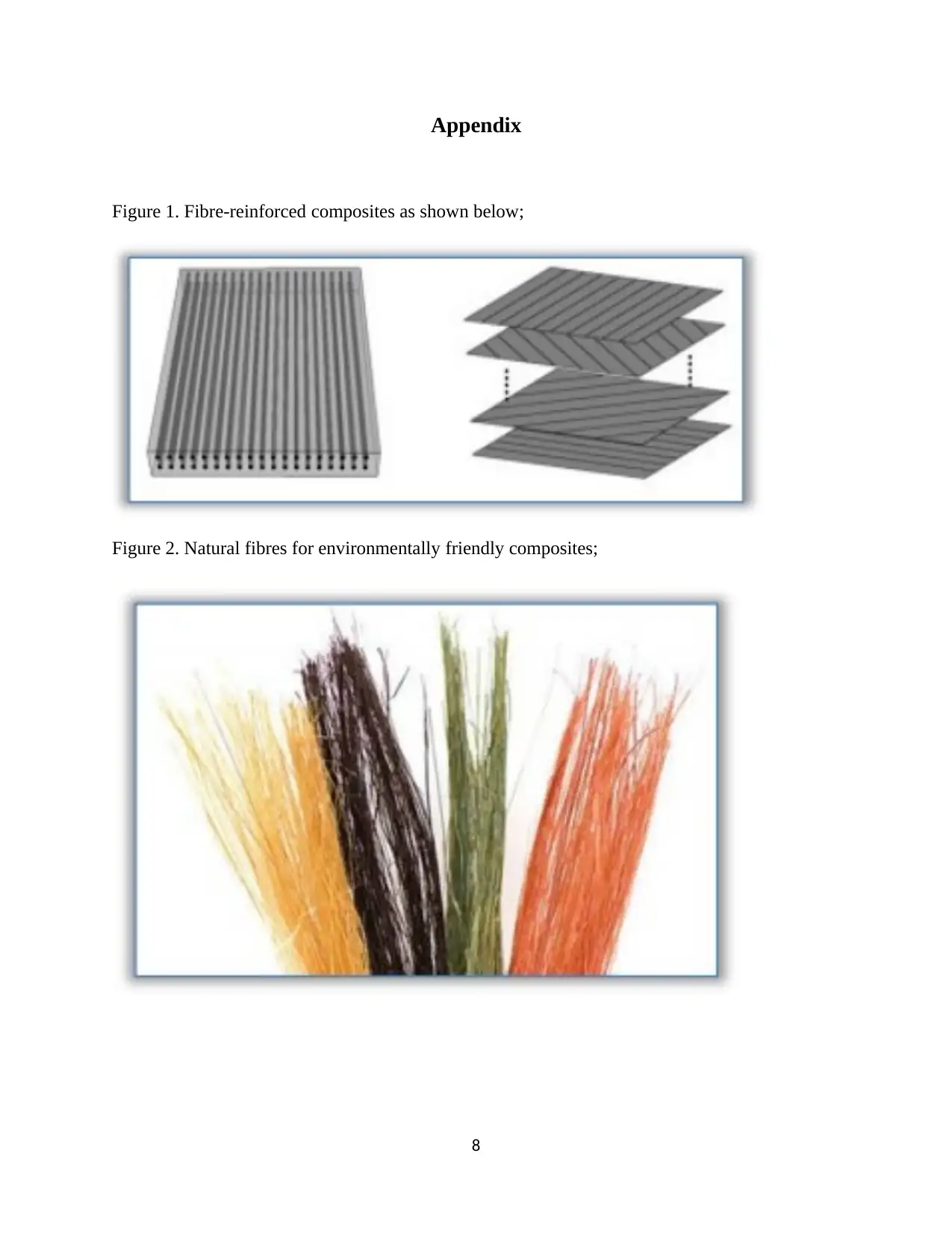
Appendix
Figure 1. Fibre-reinforced composites as shown below;
Figure 2. Natural fibres for environmentally friendly composites;
8
Figure 1. Fibre-reinforced composites as shown below;
Figure 2. Natural fibres for environmentally friendly composites;
8
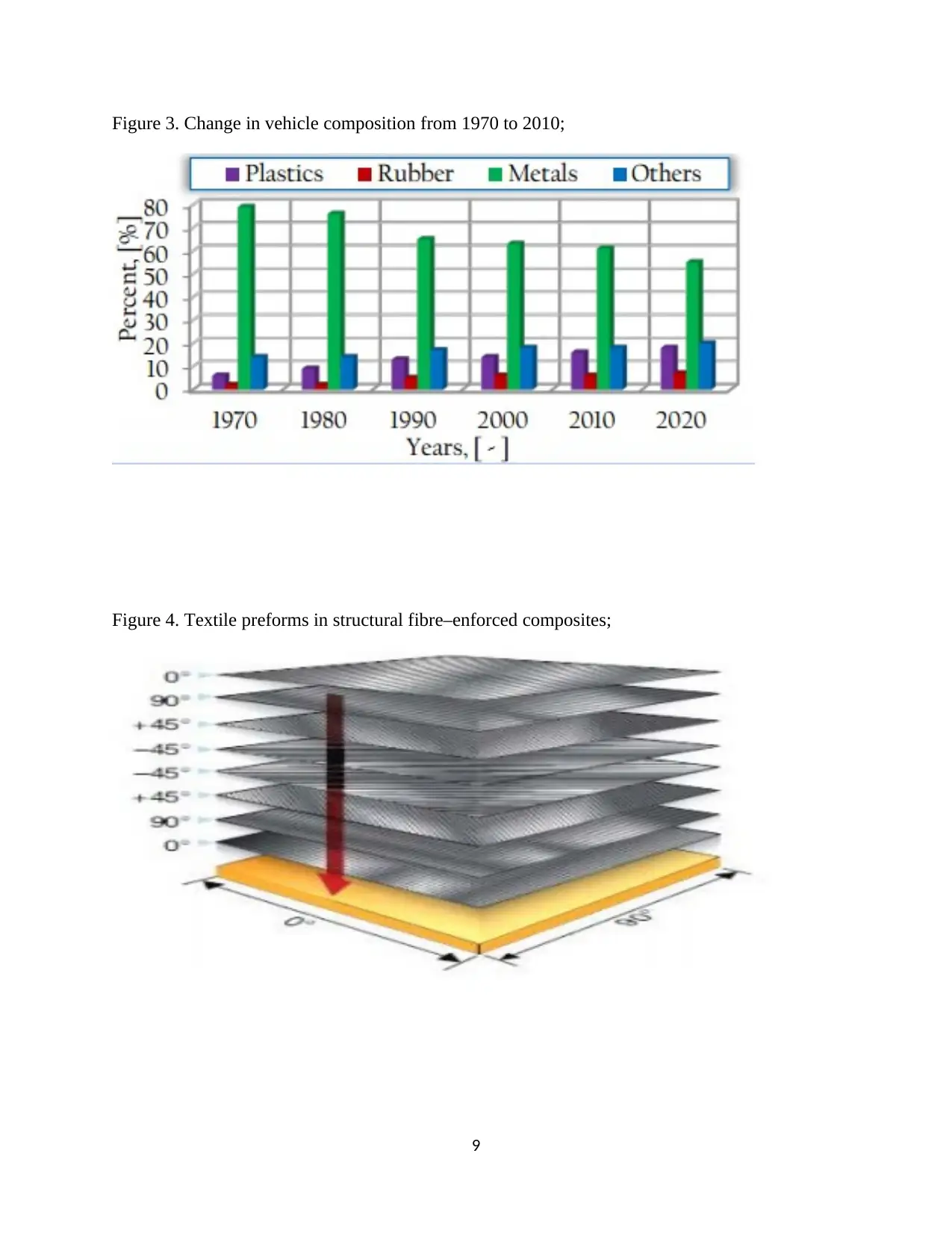
Figure 3. Change in vehicle composition from 1970 to 2010;
Figure 4. Textile preforms in structural fibre–enforced composites;
9
Figure 4. Textile preforms in structural fibre–enforced composites;
9
⊘ This is a preview!⊘
Do you want full access?
Subscribe today to unlock all pages.

Trusted by 1+ million students worldwide
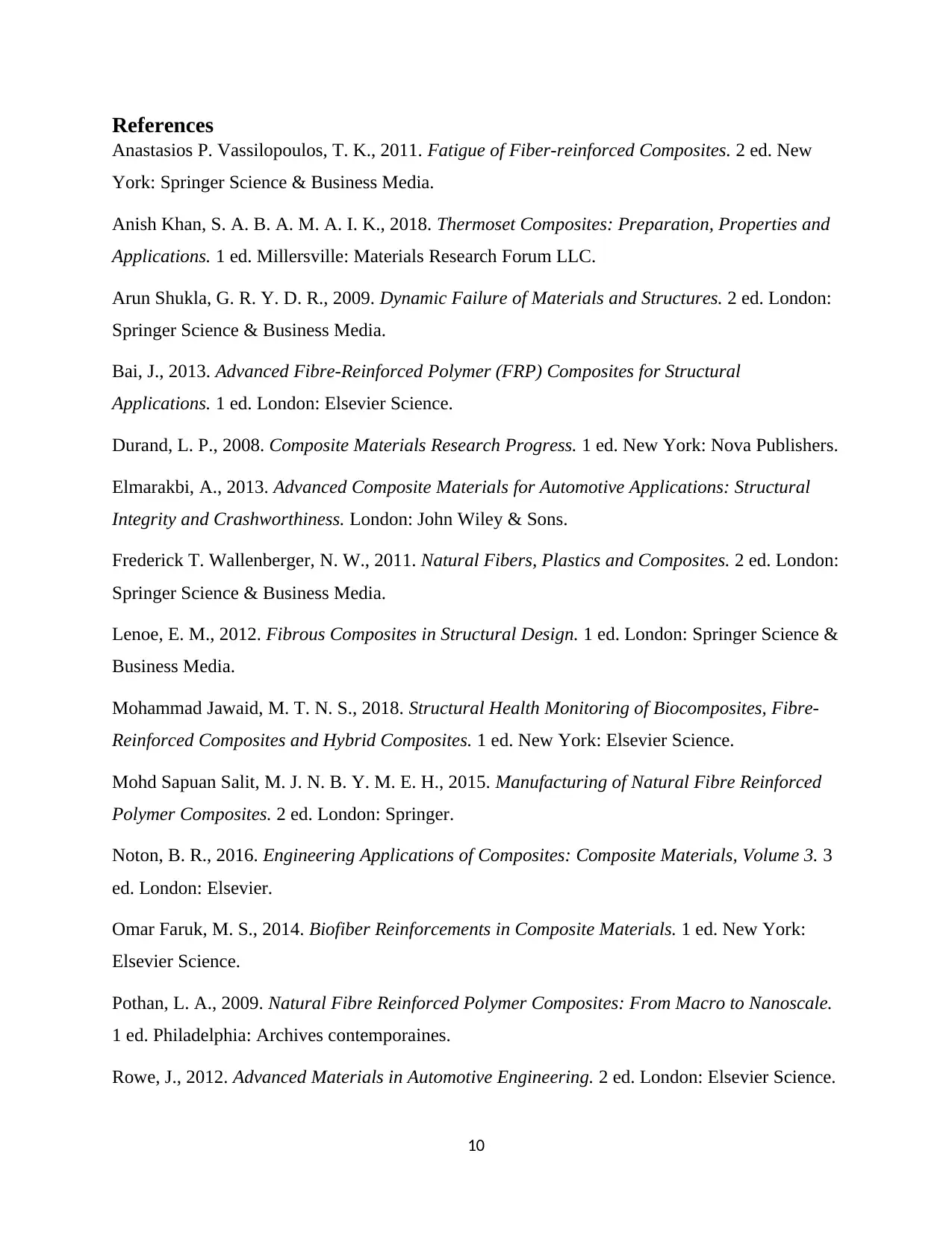
References
Anastasios P. Vassilopoulos, T. K., 2011. Fatigue of Fiber-reinforced Composites. 2 ed. New
York: Springer Science & Business Media.
Anish Khan, S. A. B. A. M. A. I. K., 2018. Thermoset Composites: Preparation, Properties and
Applications. 1 ed. Millersville: Materials Research Forum LLC.
Arun Shukla, G. R. Y. D. R., 2009. Dynamic Failure of Materials and Structures. 2 ed. London:
Springer Science & Business Media.
Bai, J., 2013. Advanced Fibre-Reinforced Polymer (FRP) Composites for Structural
Applications. 1 ed. London: Elsevier Science.
Durand, L. P., 2008. Composite Materials Research Progress. 1 ed. New York: Nova Publishers.
Elmarakbi, A., 2013. Advanced Composite Materials for Automotive Applications: Structural
Integrity and Crashworthiness. London: John Wiley & Sons.
Frederick T. Wallenberger, N. W., 2011. Natural Fibers, Plastics and Composites. 2 ed. London:
Springer Science & Business Media.
Lenoe, E. M., 2012. Fibrous Composites in Structural Design. 1 ed. London: Springer Science &
Business Media.
Mohammad Jawaid, M. T. N. S., 2018. Structural Health Monitoring of Biocomposites, Fibre-
Reinforced Composites and Hybrid Composites. 1 ed. New York: Elsevier Science.
Mohd Sapuan Salit, M. J. N. B. Y. M. E. H., 2015. Manufacturing of Natural Fibre Reinforced
Polymer Composites. 2 ed. London: Springer.
Noton, B. R., 2016. Engineering Applications of Composites: Composite Materials, Volume 3. 3
ed. London: Elsevier.
Omar Faruk, M. S., 2014. Biofiber Reinforcements in Composite Materials. 1 ed. New York:
Elsevier Science.
Pothan, L. A., 2009. Natural Fibre Reinforced Polymer Composites: From Macro to Nanoscale.
1 ed. Philadelphia: Archives contemporaines.
Rowe, J., 2012. Advanced Materials in Automotive Engineering. 2 ed. London: Elsevier Science.
10
Anastasios P. Vassilopoulos, T. K., 2011. Fatigue of Fiber-reinforced Composites. 2 ed. New
York: Springer Science & Business Media.
Anish Khan, S. A. B. A. M. A. I. K., 2018. Thermoset Composites: Preparation, Properties and
Applications. 1 ed. Millersville: Materials Research Forum LLC.
Arun Shukla, G. R. Y. D. R., 2009. Dynamic Failure of Materials and Structures. 2 ed. London:
Springer Science & Business Media.
Bai, J., 2013. Advanced Fibre-Reinforced Polymer (FRP) Composites for Structural
Applications. 1 ed. London: Elsevier Science.
Durand, L. P., 2008. Composite Materials Research Progress. 1 ed. New York: Nova Publishers.
Elmarakbi, A., 2013. Advanced Composite Materials for Automotive Applications: Structural
Integrity and Crashworthiness. London: John Wiley & Sons.
Frederick T. Wallenberger, N. W., 2011. Natural Fibers, Plastics and Composites. 2 ed. London:
Springer Science & Business Media.
Lenoe, E. M., 2012. Fibrous Composites in Structural Design. 1 ed. London: Springer Science &
Business Media.
Mohammad Jawaid, M. T. N. S., 2018. Structural Health Monitoring of Biocomposites, Fibre-
Reinforced Composites and Hybrid Composites. 1 ed. New York: Elsevier Science.
Mohd Sapuan Salit, M. J. N. B. Y. M. E. H., 2015. Manufacturing of Natural Fibre Reinforced
Polymer Composites. 2 ed. London: Springer.
Noton, B. R., 2016. Engineering Applications of Composites: Composite Materials, Volume 3. 3
ed. London: Elsevier.
Omar Faruk, M. S., 2014. Biofiber Reinforcements in Composite Materials. 1 ed. New York:
Elsevier Science.
Pothan, L. A., 2009. Natural Fibre Reinforced Polymer Composites: From Macro to Nanoscale.
1 ed. Philadelphia: Archives contemporaines.
Rowe, J., 2012. Advanced Materials in Automotive Engineering. 2 ed. London: Elsevier Science.
10
Paraphrase This Document
Need a fresh take? Get an instant paraphrase of this document with our AI Paraphraser

Vaidya, U., 2011. Composites for Automotive, Truck and Mass Transit: Materials, Design,
Manufacturing. 2 ed. Birmingham: Uday Vaidya.
11
Manufacturing. 2 ed. Birmingham: Uday Vaidya.
11
1 out of 11
Related Documents
Your All-in-One AI-Powered Toolkit for Academic Success.
+13062052269
info@desklib.com
Available 24*7 on WhatsApp / Email
![[object Object]](/_next/static/media/star-bottom.7253800d.svg)
Unlock your academic potential
Copyright © 2020–2025 A2Z Services. All Rights Reserved. Developed and managed by ZUCOL.




